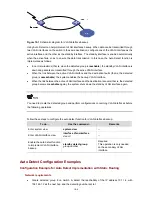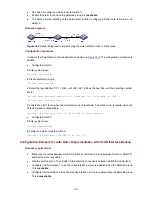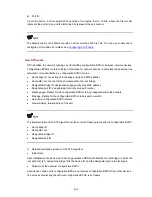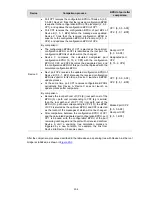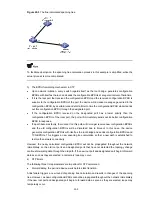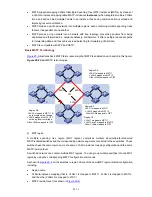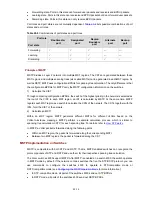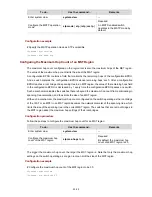
20-12
3) MSTI
A multiple spanning tree instance (MSTI) refers to a spanning tree in an MST region.
Multiple spanning trees can be established in one MST region. These spanning trees are independent
of each other. For example, each region in
Figure 20-4
contains multiple spanning trees known as
MSTIs. Each of these spanning trees corresponds to a VLAN.
4) VLAN-to-instance mapping table
A VLAN-to-instance mapping table is maintained for each MST region. The table is a collection of
mappings between VLANs and MSTIs. For example, in
Figure 20-4
, the VLAN-to-instance mapping
table of region A0 contains these mappings: VLAN 1 to MSTI 1; VLAN 2 to MSTI 2, and other VLANs to
CIST. In an MST region, load balancing is implemented according to the VLAN-to-instance mapping
table.
5) IST
An internal spanning tree (IST) is a spanning tree in an MST region.
ISTs together with the common spanning tree (CST) form the common and internal spanning tree (CIST)
of the entire switched network. An IST is a special MSTI; it is a branch of CIST in the MST region.
In
Figure 20-4
, each MST region has an IST, which is a branch of the CIST.
6) CST
A common spanning tree (CST) is a single spanning tree in a switched network that connects all MST
regions in the network. If you regard each MST region in the network as a “switch”, then the CST is the
spanning tree generated by STP or RSTP running on the "switches". For example, the red lines in
Figure 20-4
represent the CST.
7) CIST
A common and internal spanning tree (CIST) is the spanning tree in a switched network that connects
all switches in the network. It comprises the ISTs and the CST.
In
Figure 20-4
, the ISTs in the MST regions and the CST connecting the MST regions form the CIST.
8) Region
root
A region root is the root of the IST or an MSTI in an MST region. Different spanning trees in an MST
region may have different topologies and thus have different region roots.
In region D0 shown in
Figure 20-4
, the region root of MSTI 1 is switch B, and the region root of MSTI 2
is switch C.
9) Common root bridge
The common root bridge is the root of the CIST. The common root bridge of the network shown in
Figure
20-4
is a switch in region A0.
10) Port role
MSTP calculation involves the following port roles: root port, designated port, master port, region
boundary port, alternate port, and backup port.
z
A root port is used to forward packets to the root.
z
A designated port is used to forward packets to a downstream network segment or switch.
z
A master port connects an MST region to the common root. The path from the master port to the
common root is the shortest path between the MST region and the common root. In the CST, the
master port is the root port of the region, which is considered as a node. The master port is a
special boundary port. It is a root port in the IST/CIST while a master port in the other MSTIs.

